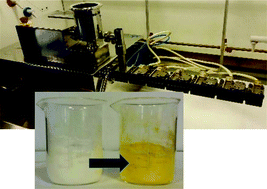Organic synthesis by Twin Screw Extrusion (TSE): continuous, scalable and solvent-free†
Abstract
Mechanochemistry provides a method to reduce or eliminate the use of solvents by carrying out reactions through the grinding of neat reagents. Until recently a significant drawback of this form of synthesis has been the limited ability to scale up. However, it has been shown that twin screw extrusion (TSE) may overcome this problem as demonstrated in the continuous synthesis of co-crystals, Metal Organic Frameworks (MOFs) and Deep Eutectic Solvents (DES), in multi kg h−1 quantities. TSE has provided a means to carry out mechanochemical synthesis in a continuous, large scale and efficient fashion, which is adaptable to a manufacturing process. Herein, we highlight the potential of this technique for organic synthesis by reporting four condensation reactions, the Knoevenagel condensation, imine formation, aldol reaction and the Michael addition, to produce analytically pure products, most of which did not require any post synthetic purification or isolation. Each reaction was carried out in the absence of solvents and the water byproduct was conveniently removed as water vapour during the extrusion process due to the elevated temperatures used. Furthermore, the Knoevenagel condensation has been studied in detail to gain insight into the mechanism by which these mechanochemical reactions proceed. The results point to effective wetting of one reactant by another as being critical for these reactions to occur under these reaction conditions.

- This article is part of the themed collection: 2017 Green Chemistry Hot Articles


 Please wait while we load your content...
Please wait while we load your content...